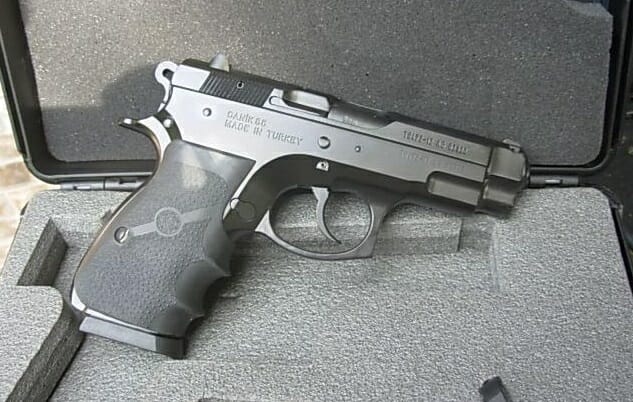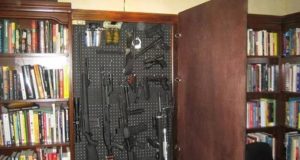Turkish gun maker Canik manufactures a compact 9mm worth looking at for daily carry, recreational shooting and home defense. Though Canik is the manufacturer, this double/single action pistol bears the name of its importer, TriStar.
The TriStar C100 has an all-aluminum frame and weighs 37.3 ounces unloaded. Its barrel is 3.7 inches. It’s not light, and it’s not tiny. However, it is compact enough for carry, and the weight helps make it a low-recoil shooter. It’s shipped with two metal 15-round mags, the followers of which are the only plastic components I can find on the gun.
The C100 has a rather easy-racking slide. Racking the slide, with a loaded magazine, chambers a round and cocks the external hammer. Unlike traditional double/single action firearms, it has no de-cocker. There is a thumb-operated safety that’s easy to use, not unlike a 1911 safety. The pistol is thus capable of being carried “cocked and locked,” avoiding the long double-action trigger pull if desired.
For those who prefer a double-action first shot, for safety or nostalgia, it’ll do that, too. It’s necessary to de-cock the hammer using both the trigger and a thumb on the hammer to let it down softly. Since this requires breaking one of the firearm safety rules, keep your finger off the trigger until the sights are on target and you’re ready to shoot. Be sure to honor another safety rule: Never allow the muzzle to cover anything you’re not willing to destroy during de-cocking.
You Don’t Need A Firearms License For This Weapon!
The trigger’s operation in double-action mode is heavy, in excess of 12 pounds, but smooth. In single action, there’s still a slight bit of takeup. In both modes, the break is crisp and the travel is buttery.
Textured grips have indentations in all the right places to make this non-modular handgun fit an impressive range of hand sizes. Deep sculpts at the trigger-finger area shorten the distance from backstrap to trigger. The mag release is a fairly easy reach, as well.
The ergonomic assets continue with the low-bore axis of this pistol. In 9mm, it’s a treat to shoot, with very little recoil. The C100 also comes in .40 S&W, which I have not tested.
Under the barrel is a standard rail, long enough to accommodate most tactical pistol lights. Although a DA/SA handgun isn’t my choice for home defense, this one will do the job.
On the range, the C100 has so far been dependable, with a variety of brass- and aluminum-cased ammo, both FMJ and hollow point. I was expecting misfeeds resulting from incomplete or delayed ejection of brass from its small, right-side only ejection port. Those misgivings turned out to be unfounded.
Accuracy is good from this little gun, in no small part due to the rails that run the entire length of the frame. The barrel is not fixed, but its range of deviation is less than half that of typical polymer pistols.
The three-dot sight system on this pistol is better than it needs to be for an economy gun. They’re steel, and the rear sight is drift-adjustable. It’s easy to distinguish the front from rear-sight dots as the front one is larger, but not gaudy. The rear sight has rounded edges that are concealment-friendly.
There is detailed texturing on the pistol, with a line of about 12 custom-looking grooves along the top of the slide, grippy-cocking serrations, and grip panels with sandpaper-like texturing for the lower fingers. Such detail is quite unexpected and lovely to behold, but could prove annoying for those who work in dusty conditions or roll around on the ground with the gun.
For the person who wants a classic profile and a solid metal handgun for daily carry, the C100 just may fit the bill. For the family wanting to have one gun every trained member of the household can easily use, it fits the bill. Thanks in part to having a rail and 15+1 capacity along with a trim size, the C100 will make a top pick for anyone needing versatility from their handgun.
The price is right, too. Currently, the C100 is typically priced around $360.
Incidentally, much ado has been made about whether the C100 is a clone of the CZ 75. In many ways, especially its profile, it appears to be. I, for one, wouldn’t hesitate to choose this well-made new model over the CZ, especially where budget is concerned.
Have you ever shot a C100? What did you think? Share your thoughts in the section below:
 Off The Grid News Better Ideas For Off The Grid Living
Off The Grid News Better Ideas For Off The Grid Living




